How Generative AI and Art Nouveau Can Transform Urban Aesthetics
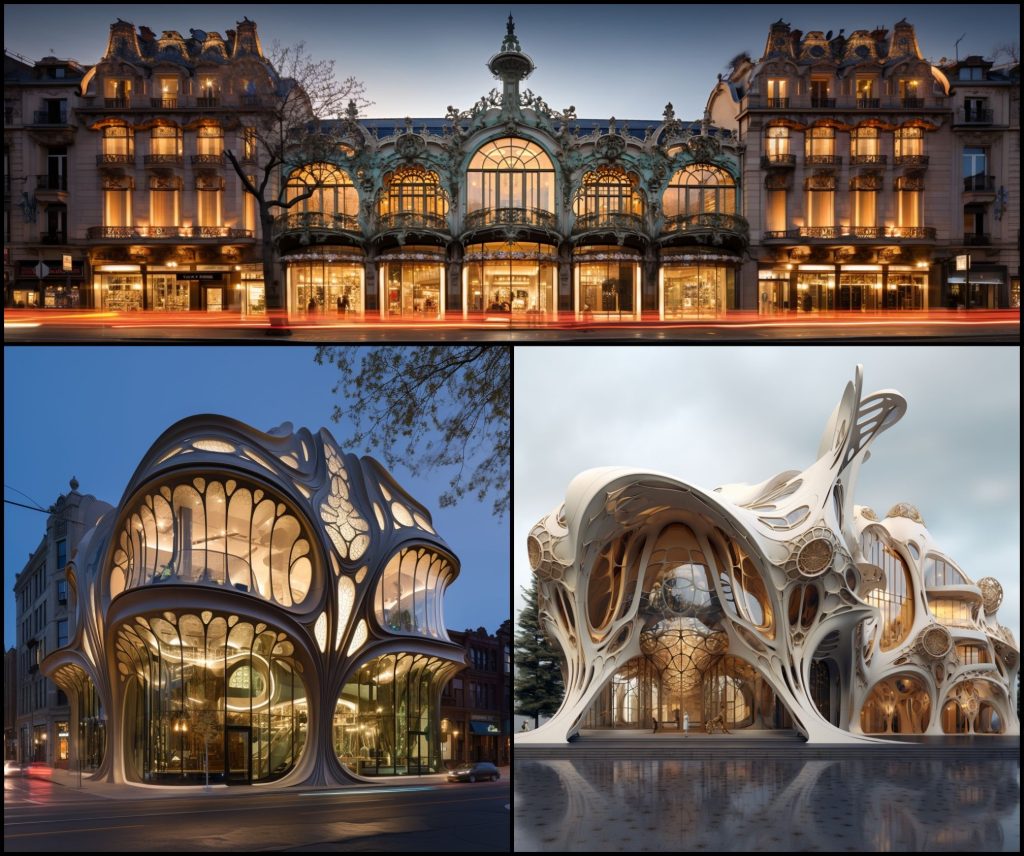
Introduction
Art Nouveau, with its whimsical approach, fantastical ideas, and unabashed celebration of beauty and nature, is like a fairytale brought to life in an absinthe-fueled fever dream. For over a century, Art Nouveau design has taken a back seat to more austere, manufactured, and geometrical design schools like modernism and minimalism, but today interest in this incredible style is slowly seeing a revival thanks to one revolutionary new trend: generative artificial intelligence. The power to rapidly create AI generated architecture concepts is allowing innovative designers to develop and reimagine design styles both new and old and is priming the architecture world for a renaissance of creativity. As a result, many are realizing the ability of some AI models to recognize and generate intricate highly detailed images makes them uniquely suited for exploring the intricate organic forms associated with Art Nouveau and finding ways to apply this beautiful design style.
So why kick off this blog by discussing a style largely declared dead over 100 years ago? The truth is, it never really died. Rooted in a timeless embrace of nature, it’s been patiently awaiting its resurgence. Just like a desert flower seed, it simply lacked the ideal conditions to flourish after the 1910s. However, it seems those conditions have finally arrived.
In 2023, we find ourselves yearning for something more than the blasé desert of developer modernism, normcore, or the monotony of earth tones and rectangles. We’re craving a bloom of creativity, akin to desert flowers after a flash flood. The accelerating adoption of AI in the design world has shown that AI generated architecture can provide that deluge of inspiration that a style like Art Nouveau needs to thrive. So how can you use generative AI to incorporate more of this incredible style in your practice? Does Art Nouveau deserve a revival and if so, what might it look like? Read on and decide for yourself.
Outline
The role of artificial intelligence in architecture and design is expanding rapidly, letting designers rapidly generate, combine, and expand upon their ideas. By simply inputting text or other images, today’s AI image generators can recognize countless design styles and produce original images inspired by those styles and based on the directions of the designer. However, with infinite design possibilities, we must stop to think what concepts and styles we should embrace. What AI assisted design workflows should we consider? How can we construct these ideas in reality? To explore these ideas, in this post we will cover:
- History of Art Nouveau
- Early History
- Key Figures and Features
- An Eventual Decline
- Art Nouveau’s Lasting Influence
- A Contemporary Art Nouveau Architecture
- Subtle Sensibilities
- Dreams of Paris
- A Timeless Luxury
- A Style for All
- Eye-Catching Elegance
- A Focus on Urban Fabric
- Modernism Meets Modernisme
- The Optimism of AI Architecture
- Making Fantasy Reality
- Dabbling in Interior Design
- Unpacking AI – A Peek Behind the Pixels
- Assessing Practicality
- Why Now? – An Ironic Conclusion
- Coming up…
1. History of Art Nouveau
Early History
Before we imagine Art Nouveau’s future in architecture, let’s delve into its past. The term “Art Nouveau” originated in 1884 when it was used to describe the work of Les Vingts, a group of artists aiming to unify all art forms and challenge the notion that decorative arts (e.g., pottery, carpentry, glass working, and metalsmithing) as less respected than the fine arts (painting, sculpture, etc.) [1]. It gained further prominence through the Parisian gallery “La Maison de l’Art Nouveau” and debuted as an architectural style with the works of Victor Horta, who is often considered the father of Art Nouveau architecture. It tended to have a different name in each country such as Jugendstil in Germany, Modernisme in Spain, Tiffany Style in America, and Glasgow style in Scotland, but at its birthplace in France and Belgium as well as much of the world, it went by Art Nouveau [2].
Art Nouveau emerged as a response to the industrialized world’s gloominess and instead took an optimistic, whimsical approach to design promoting integration of art and nature with everyday life as well as the ideal of beauty for beauty’s sake. It offered an alternative to competing styles like the heavy utilitarianism of Victorian, the stuffiness of neoclassical or neogothic, or the seriousness of a similar yet toned down style, the Arts and Crafts movement.
Key Figures and Features
Known for its floral patterns, whiplash curves, and elegant silhouettes, it emphasized the equality of all design disciplines, from towering facades to delicate glassware. From the glass creations of Émile Gallé to the very commercial yet beautiful illustrations of Alphonse Mucha, Art Nouveau found a place in all sorts of art forms. Works from some of the most famous art nouveau artists and designers are illustrated below as an example:
| Louis Majorelle Interior Designer | Hector Guimard Architect | Émile Gallé Glassmaker |
| | | |
| Louis Comfort Tiffany Stained Glass Designer | Victor Horta Architect | Margaret Macdonald and Charles Rennie Mackintosh Interior Designers |
| Aubrey Beardsley Illustrator | Alphonse Mucha Illustrator | Antoni Gaudí Architect |
Ironically, despite Art Nouveau’s celebration of nature and reaction to industrialism, it embraced materials made possible by the industrial revolution—wrought iron, stained glass, plaster, etc. [3] However, one could argue that’s more a feature than a bug since the movement’s real goal was to develop ways to harmonize and integrate natural beauty into a modern industrialized world. To that end, it included abundant nature motifs like grasshoppers, dragonflies, butterflies, birds of paradise, and peacocks. The style’s architecture boasted extraordinary stairs, ornate lamps, and and soaring organic arches. It was elaborate yet modest, unique and outspoken. In its efforts to be original, it discovered new ways to make use of both progressivism and historicism [4].
An Eventual Decline
Reaching its zenith at the Exposition Universelle in 1900 [4], Art Nouveau’s popularity spread through marketable and mass-produced pieces. However, its dominance was short-lived and lasted only from the 1880s to the outbreak of World War I in 1914.
At the time it was seen as a luxury style that required skilled craftsmen and could not be scaled and produced affordably for everyday people. This association with wealth and influence may have been a part of what led to its demise. The austerity and disillusionment that came about during and after World War I also helped to crush the uniquely optimistic outlook of Art Nouveau. Modernist movements like Art Deco, with its characteristic sharp angles and geometric shapes quickly supplanted the more organic forms of Art Nouveau as the style of choice for trendy designers, especially as France’s cultural influence was replaced by a more English, American, and German driven culture. Finally, since Art nouveau was more prevalent in private residences than public spaces, it quickly faded from the public consciousness, further hindering its survival [4].
Art Nouveau’s Lasting Influence
The 1910s weren’t the last we would see of Art Nouveau. In the 1960s it captivated the public consciousness once more as the psychedelic movement drew upon its whiplash curves, vibrant colors, and ideas about beauty and the environment [2]. Yet that movement too came and went as youth culture evolved. 30 years later the 1990s saw a similar but more toned down embrace of Art Nouveau’s design principles, only faintly echoing previous movements.
Now, decades later, there have been attempts to revive the style, particularly in interior design (e.g. Bohemian style). However, in new architectural design and in the facades we experience as urban fabric, Art Nouveau remains dormant. And while I would highly recommend spending the time to watch the linked videos from the amazing creators cited above, that brings us to today. So, as we move forward, let’s explore how AI can potentially rekindle this artistic flame.
2. A Contemporary Art Nouveau Architecture
While Art Deco is having a bit of a comeback now as an ultra-luxury style in New York (more on that in a future post), Art Nouveau is a bit of a sleeper hit. Designers here and there have been picking up on a desire to rediscover the maximalism, antique aesthetic, and biophilia inherent in Art Nouveau, with various styles like Boho, Cottagecore, and French Revival drawing on it occasionally. It has been featured in a few articles as an emerging trend [5][6]. However, these rely more on piecing together antiques and other existing designs, rather than promoting original works. To start a true design movement, Art Nouveau needs to make a splash in architecture and specifically facade design. To that end, AI architecture image generators can play a pivotal role and give us ideas of what form an Art Nouveau revival could take.
Subtle Sensibilities
So what could a contemporary Art Nouveau building look like in 2023? It might begin modestly, with ornamentation and a preference for timeless natural materials like wood, stone, and plaster. Subtle organic curves in the façade could hint at iconic Art Nouveau concepts. You might need to zoom in and look closely to spot these details, but it might look something like this:
Dreams of Paris
One could also take a bigger more fanciful approach, with cues that blend early examples of the Art Nouveau architecture found in Paris and the grand Haussmann style architecture that preceded it, with whimsical motifs but a stately rhythm echoing the styles found throughout the City of Lights:
A Timeless Luxury
It could continue on its roots as a luxury style:


A Style for All
Alternatively, maybe modern fabrication and construction techniques like laser cutting, CNC fabrication, 3D printing, prefabrication, and innovative materials could democratize the intricate detailing of Art Nouveau, making it more economical and suitable as a style for the fabled “missing middle housing” (e.g. townhomes, duplexes, fourplexes, etc.).
With smaller missing middle housing projects there is more leeway for architects to get creative with the detailing compared to large developments that often just aim to be unobjectionable. This makes mid-size developments like townhomes the perfect proving ground for the intricate concepts AI facilitates. For example, CNC fabrication and 3D printing generally don’t rely on economies of scale, making them an economical choice for prototyping detailed facade elements on a smaller project. With these modern tools paired with generative AI architecture, designers could be freed to rediscover ornamentation as a way of making homes fun, whimsical, and eye catching, while still keeping everything at a smaller more modest scale so they can be built faster and in more places than the megaprojects being constructed today. With the right design and fabrication choices, the housing stock of tomorrow could go from dull imposing boxes to something more like this:
Eye-Catching Elegance
With any style you need to push the boundaries sometimes, and in certain building types like commercial spaces, being eye-catching is key. Fortunately AI architecture image generators excel at coming up with eye catching ideas. For example, a commercial or mixed-use building that really wants to stand out could embrace art nouveau revival to create an intricate statement centerpiece, but include more traditional wings that harmonize with the street and surrounding buildings, like so:


A Focus on Urban Fabric
We could focus less on the intrace flourishes and more on the materiality. A contemporary Art Nouveau could infuse the warm materiality and rustic charm of 19th century materials like brass, stone, and wood into public spaces weaving through our urban areas, drawing inspiration from structures of the 1900 Exposition Universelle that helped this style spread around the world in the first place:


Modernism Meets Modernisme
Perhaps we don’t completely eschew sleek modern design trends, but instead blend them with Art Nouveau’s more natural materials for an elevated design while still conforming to modern expectations. For example, maybe we consider a modern mixed-use building with an earthy, sculptural stone aesthetic akin to the museum/residences at Antoni Gaudí’s “La Pedrera”, which exemplifies the branch of Art Nouveau developed in Barcelona called Modernisme:


The Optimism of AI Architecture
Imagine a residential tower that trades drab blockiness for gleaming brass, colorful filigree eaves, cozy wood millwork, and expansive covered terraces providing a connection to the outdoors to embody the style’s embrace of nature:
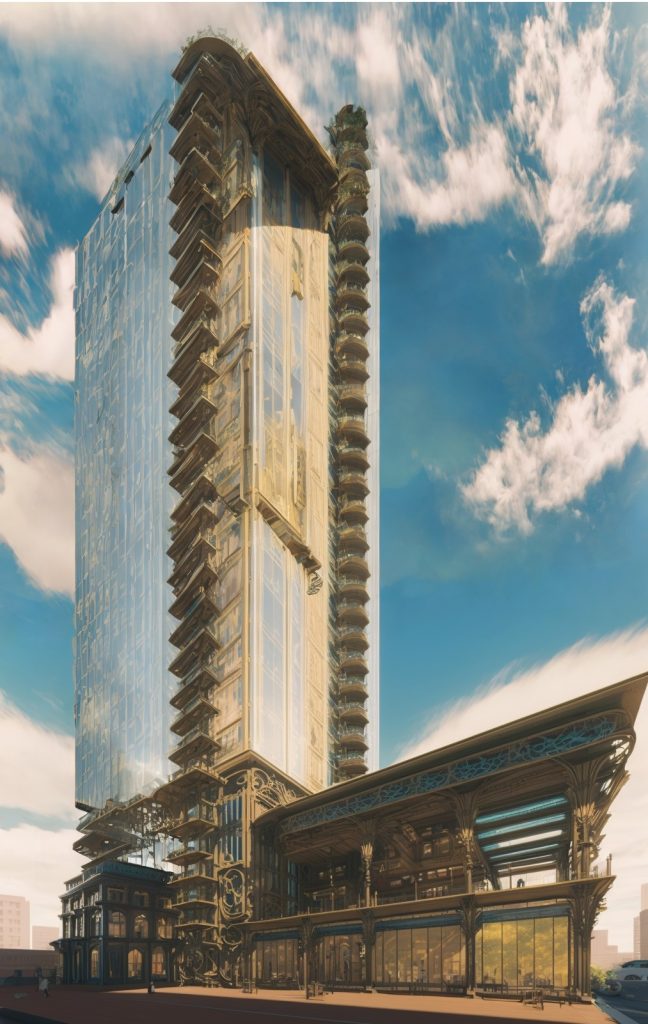
Making Fantasy Reality
And then eventually some architect has to go completely off the deep end and just start designing an elven fairytale village or fantastical wrought iron masterpiece, because we could all use a bit more wonder and magic in our lives:
With each concept, the devil is in the details. Sure, there are a few nonsensical ideas in most AI architecture images. Irregular windows; Structural elements that do nothing; Floors that defy gravity. However, it’s the designer’s role to identify those issues and correct them when developing the design further and there are many more details hidden in these images that spark inspiration and offer ideas we may never have thought of. Using AI to further develop these details past the concept phase will be the topic of another post and admittedly some take a little imagination to interpret what the AI is trying to show, but that’s half the fun.
So go ahead. Look closely. You’ll be surprised what you find and what might bring you inspiration.
3. Dabbling in Interior Design
You may want to know what the interiors of all these concepts might look like, and yes one could easily do a less flashy, more personal and pared down interior design for occupants to express themselves. But if you’re really aiming for a cohesive interior and exterior design philosophy, Art Nouveau does make for just the coziest and most playful interiors. This is especially true when blended with modern interior design sensibilities, but that’s a topic for another post. Here’s a preview though:
Have any design projects you would like to share? Email acanthus@pixelstoplans.com about your project if you would like to have it featured in a future post.
4. Unpacking AI – A Peek Behind the Pixels
While AI image generators are fun to experiment with, let’s take a look under the hood to understand a bit more about how they really work and how they make the images in the examples above. Generative AI comes in many flavors, but we’ll be looking at the most common method for the examples shown above: diffusion-based image generators.
Put simply, diffusion is a machine learning algorithm that first trains an AI to identify and reconstruct progressively blurrier and noisier images by identifying what’s in the image and adjusting the pixels to clean up the noise. For example, let’s say you’re training it to identify a stoplight (sound familiar?). Once the model has developed a concept of what “stoplight-like” pixels looks like, it can take a blurry image or field of random noise, find the most “stoplight-like” pixels and start adjusting them step-by-step to produce an image. So what happens if you want to combine multiple concepts and have it draw an Art Nouveau stoplight? Well with enough Art Nouveau images in the training data, it will get a concept for what that looks like too, creating some very stylish results.
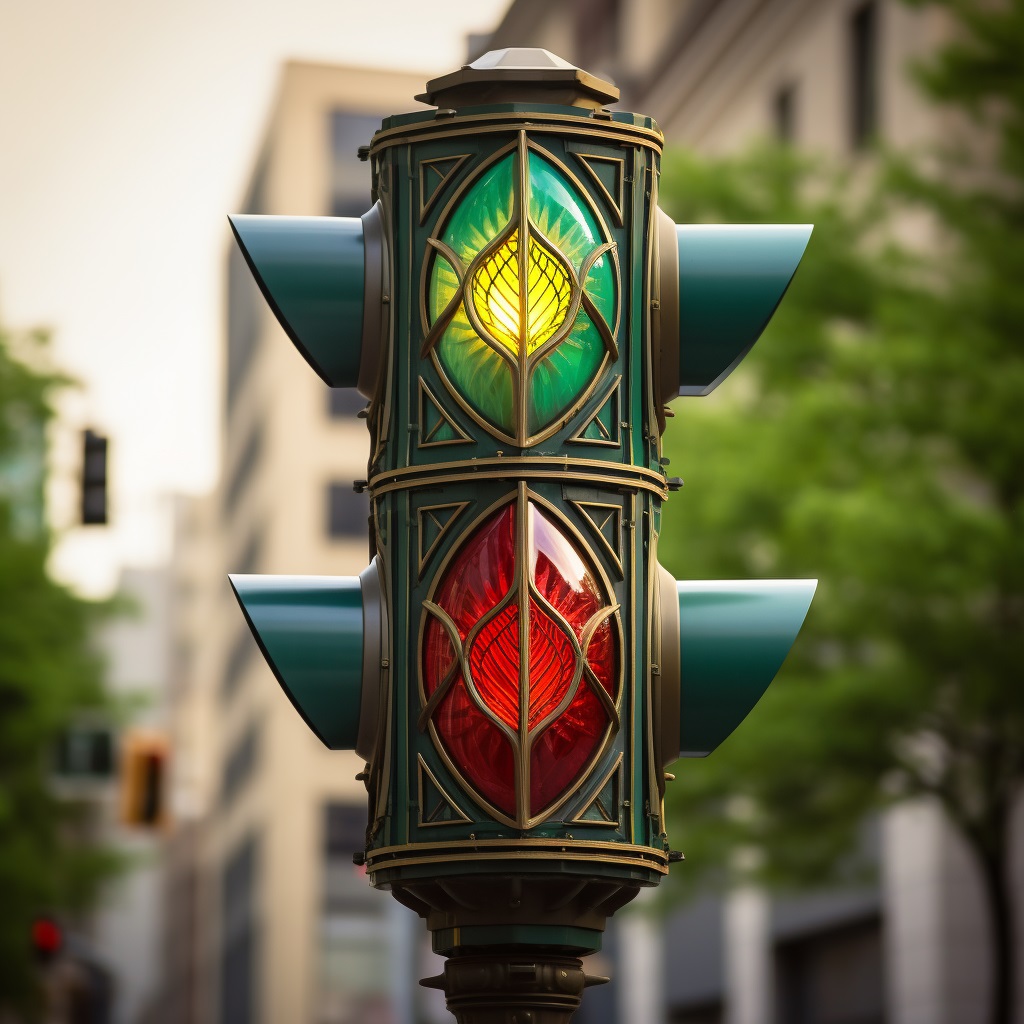
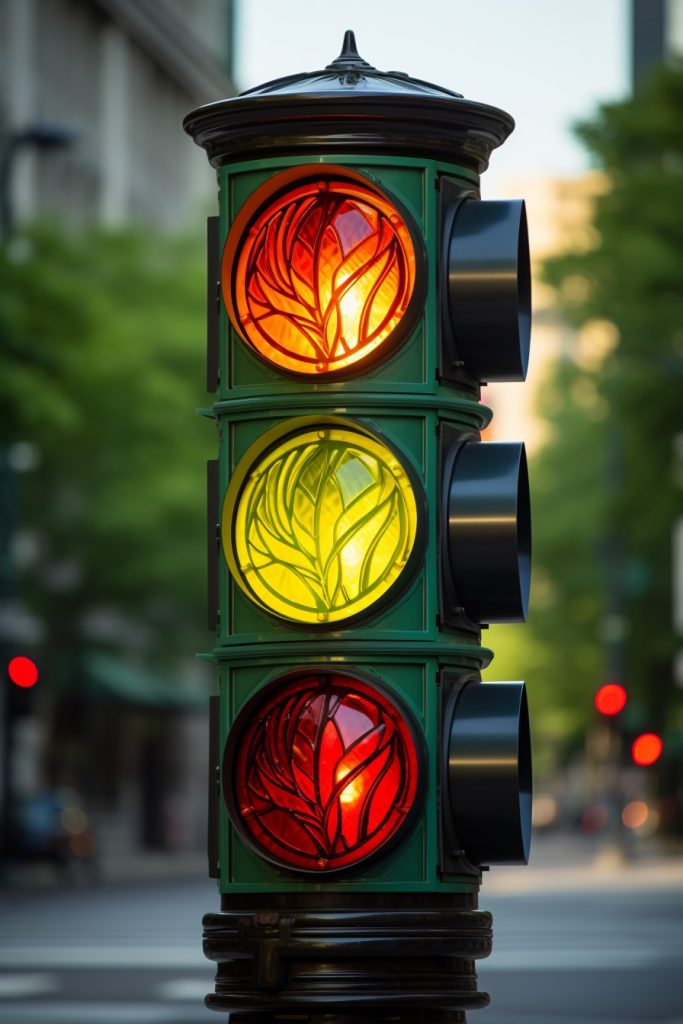

It’s a bit like cloud watching. Sure, that cloud might just be a puff of condensed water vapor. But as humans, we know when it looks like a rabbit and our imaginations can fill in the blanks of what should be there to see it as a rabbit[x][xi].
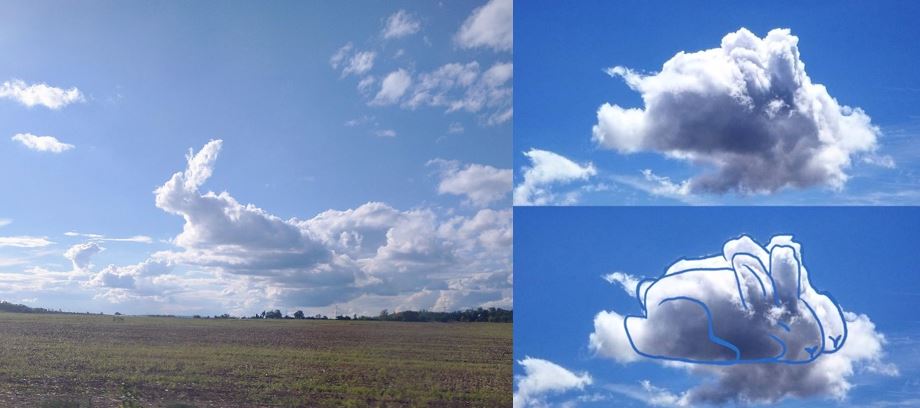
As of September 2023, numerous AI tools have become available, each with its strengths and weaknesses, so it is important to understand the use cases for each one. Images in this blog use one or more of the following platforms:
- Midjourney: The biggest name in image generators right now, excelling at turning simple prompts into high-quality images.
- Playground AI: A freemium AI model that’s good for rapid idea variations. While results are often not quite as polished or stunningly artistic as Midjourney, its image-to-image features are excellent at generating variations on a specific composition (important for buildings which require a lot of variation on a specific massing to further develop a design)
- Additional tools like Vizcom, Dall-E, Blue Willow, Look X, PromeAI and others.
Future posts will dive deeper into the workflow for each of these to provide roadmap of how to use generative AI in your architectural practice. However the examples in this article should give you an idea of how powerful these tools are for developing design ideas.
Interested in exploring other AI generated architecture concepts and design workflows? Sign up for our free mailing list below to be notified whenever we post new content here on Pixels to Plans.
5. Assessing Practicality
Of course we have to ask: is art nouveau construction in modern times even practical? I would argue it absolutely is — more so than at its inception in the 1800s. Originally, Art Nouveau was a luxury style, often exclusive and inaccessible to most people. Today though a convergence of technologies has changed the game. We now have 3D printing, laser cutting, advanced materials like silicones and adhesives, and a host of other fabrication techniques at our disposal. These tools could empower creative designers to bring their concepts to life on a grand, cost-effective scale. Art Nouveau, known for its rejection of industrial drabness while creatively utilizing industrial products, could easily flourish in this new technological era and the power of AI architecture image generators to rapidly produce design variations can help architects find new and creative ways to achieve their design intent.
AI has democratized this type of design, so the style should evolve to reflect that. The key to developing an AI-inspired Art Nouveau revival style with modern sensibilities is to explore and determine which ideas also democratize the style and make it something everyone could enjoy. A well justified backlash to excess and fantasy killed Art Nouveau the first time around, but maybe it was just waiting until it had an answer to the very real challenges of everyday people in the 20th century; waiting to fulfil its promise of transcending tradition and rejecting industrial drudgery.
In a quest to turn fantasy into reality and offer beauty for beauty’s sake, the path forward lies in practicality. In the 1920s, Art Deco emerged as a solution (which we will get into in the next post) but Art Deco was a product of its times and a solution using the tools they had on hand. Now, we must seek a solution tailored to the tools and challenges of the 2020s instead of the 1920s.
We may very well be entering a new Metamodern era in design, emphasizing sincerity, pluralism, and open-mindedness. This is a period when many are attempting to balance modernism’s practicality, historicism’s reverence, and postmodernism’s humorous cynicism while rejecting the less desirable aspects of these philosophies. In this context, what could be more fitting than a design style that expresses a love of nature and adds joy and whimsy to the world? Art Nouveau fits the bill.
6. Why Now? – An Ironic Conclusion
The irony of Art Nouveau was its use of technology and industry to celebrate nature while rejecting utilitarian monotony and still building to accommodate burgeoning populations in the late 1800s. Today, we find ourselves amidst a similar era of unimaginative, bland developer modernism and uninspiring architecture on top of an unprecedented housing shortage. The parallels are hard to ignore, making it apt that the response to this modern problem should once again draw inspiration from an even more modern solution: Generative AI.
AI presents ethical considerations for individuals and the industry. Opinions on AI range from “It’s evil, don’t touch it!” skepticism to curiosity and all to way to full-on “Welcome robot overlords” acceptance. Regardless, AI is here to stay and as designers, we must learn to harness this new tool. In doing so, we have the potential to create architectural marvels that will enrich the tapestry of our environment and stand the test of time.
Is Art Nouveau the ideal source of inspiration for this new era? Perhaps. However, the idea of an AI Art Nouveau revival is just one of the many topics we’ll explore as we delve into AI’s role in urbanism and architecture, and turn design ideas from Pixels to Plans.
7. Coming up…
While Art Nouveau exemplifies a style uniquely suited for an AI-driven revival, it’s only the beginning of the creative possibilities designers are now discovering. In the next post, we’ll dive into Art Nouveau’s younger brother, Art Deco, examine how it’s making a comeback, and explore how AI may influence its revival and future design trends.

About the Author
AcanthusAlchemist
Designer and engineer exploring the intersection of AI, architecture, and urbanism.
email: acanthus@pixelstoplans.com
Interested in exploring other AI generated architecture concepts and design workflows? Sign up for our free mailing list below to be notified whenever we post new content here on Pixels to Plans.
Citations:
[1] Wayfair – How Art Nouveau Raged Against The Machine | A Style Is Born w/ @KazRowe
[2] Vox – Where the 1960s “psychedelic” look came from
[3] Europeana – Art Nouveau Architecture and Interiors
[4] Radio Retrofuture – The History of Art Nouveau Architecture and Design | From Horta to Guimard
[5] Forbes – In 2023, Will We Fall Back In Love With Sexy, Slinky Art Nouveau?
[6] Designwanted – Is Art Nouveau making a comeback? Here’s a design guide, just in case
Image References:
[i] Gallerie Yves Gastou – Louis Majorelle Art Nouveau Armchairs
[ii] I Prefer Paris – Hector Guimard Buildings on Rue Jean de la Fontaine
[iii] Skinner Inc. – Emile Galle and the Lasting Appeal of Art Nouveau Glass
[iv] Christies – 10 Things you Need to Know to Collect leaded Glass Lighting by Louis Comfort Tiffany
[v] UNESCO World Heritage Convention – Major Town Houses of the Architect Victor Horta (Brussels)
[vii] Wikipedia – Aubrey Beardsly – Peacock Skirt
[viii] Meister Drucke – Alphonse Mucha: La Danse Lithographs
[ix] SerenTripidy – Gaudí Barcelona: Casa Batlló, The House Of The Dragon
>> “making it more economical and suitable as a style for the fabled “missing middle housing” (e.g. townhomes, duplexes, fourplexes, etc.).”
The cost of the actual construction aside, I think a part of this would require more liberal zoning policies that support small-scale landowners, as they would be more open to experiment with unique styles like these. I feel like many new mid-rise and high rise apartment blocks these days are built by large development companies, who are more focused on profit generation than creative ingenuity. The Japanese are known to be more creative with their housing design, despite land scarcity, and might be interesting to study their land use policy.
Henry George is the 19th century American political economist who understood that economic rents are in complete contradiction to social wealth. Eliminate rents, and people will be free to do more, build more, and enjoy more, because the overhead costs would be greatly reduced and/or eliminated. Unless we make huge changes, America is doomed to all work and no play, including in building and design.